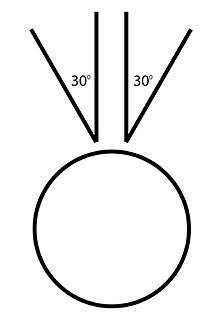30-degree rule
The 30-degree rule is a basic film editing guideline that states the camera should move at least 30 degrees relative to the subject between successive shots of the same subject. If the camera moves less than 30 degrees, the transition between shots can look like a jump cut—which could jar the audience and take them out of the story. The audience might focus on the film technique rather than the narrative itself.[1]

The 30 degree change of angle makes two successive shots different enough to not look like a jump cut. However, camera movement should stay on one side of the subject to follow the 180-degree rule. Also, when thinking about the 30 degree rule, it is important to change the focal length of the lens at least 20 mm with each move you make on the axis. The 30 degree rule is often called the "20 mm/30 degree rule" for this reason.[2] The axial cut incorporates the 20mm idea by moving the camera either closer or farther away from the subject without moving on the axis. This type of edit does not follow the 30 degree rule but deliberately breaks it to get a particular effect. Filmmakers sometimes break conventional film technique rules to achieve particular effects.
French filmmaker George Méliès, producer of silent black-and-white film, made films before the 30 degree rule existed. Méliès inspired succeeding filmmakers to heed this rule of angle when cutting between similar or nearly identical clips. When Mèliés himself made his famous A Trip to the Moon (1902), he edited together film clips of the same framing and with the same angle, after changing the scene between the shots, to make it look like there was no cut at all. It was the world's first attempt to make special effects, made up of jump cuts.[1]
As Timothy Corrigan and Patricia White suggest in The Film Experience, "The rule aims to emphasize the motivation for the cut by giving a substantially different view of the action. The transition between two shots less than 30 degrees apart might be perceived as unnecessary or discontinuous--in short, visible."[3] There are some cases where jump cuts are used to show a passage of time or used to achieve an aesthetic style but generally filmmakers try to avoid them otherwise.
The 30 degree rule is a special case of a more general dictum that states that the cut is jarring if two shots are so similar in angle and distance that it appears there is no reason for the cut. In his book In The Blink of an Eye, editor Walter Murch states:
"[We] have difficulty accepting the kind of displacements that are neither subtle nor total: Cutting from a full-figure master shot, for instance, to a slightly tighter shot that frames the actors from the ankles up. The new shot in this case is different enough to signal that something has changed, but not different enough to make us re-evaluate its context."[4]
See also
References
- "30 Degree Rule - Hollywood Lexicon". Archived from the original on 2017-02-01.
- Hurbis-Cherrier, Mick (June 30, 2011). Voice & Vision (2nd ed.). Focal Press; 2 edition. p. 600. ISBN 0240811585.
- Corrigan, White, Timothy, Patricia (2013). The Film Experience (3rd ed.). Bedford/St. Martin's. ISBN 0312681704.
- Murch, Walter (2001). In the Blink of an Eye: A Perspective on Film Editing (2nd ed.). Silman-James Press. pp. 146. ISBN 1879505622.
External links
- "The 30-degree rule", an article explaining the 30-degree rule in depth (showcasing examples and counterexamples from various films).